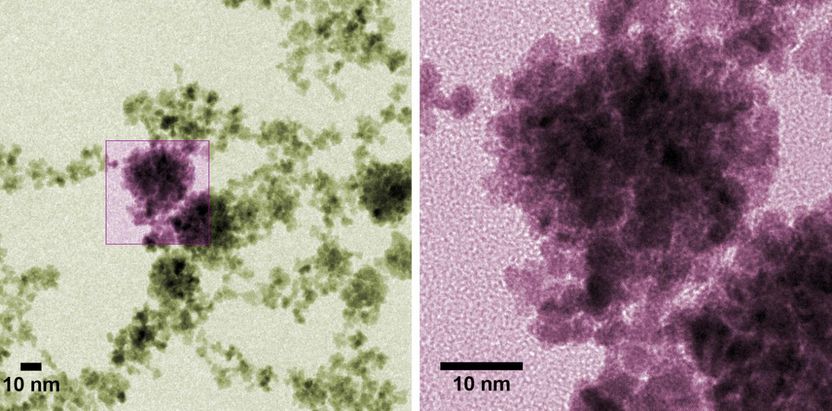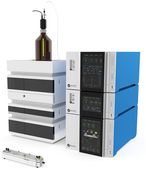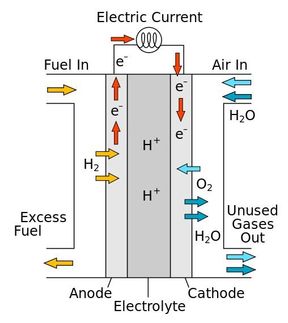NIST's 'nano-raspberries' could bear fruit in fuel cells
Researchers at the National Institute of Standards and Technology (NIST) have developed a fast, simple process for making platinum 'nano-raspberries' - microscopic clusters of nanoscale particles of the precious metal. The berry-like shape is significant because it has a high surface area, which is helpful in the design of catalysts. Even better news for industrial chemists: the researchers figured out when and why the berry clusters clump into larger bunches of 'nano-grapes.'

Colorized micrographs of platinum nanoparticles made at NIST. The raspberry color suggests the particles' corrugated shape, which offers high surface area for catalyzing reactions in fuel cells. Individual particles are 3 to 4 nanometers (nm) in diameter but can clump into bunches of 100 nm or more under specific conditions discovered in a NIST study.
Courtesy of Curtin/NIST
The research could help make fuel cells more practical. Nanoparticles can act as catalysts to help convert methanol to electricity in fuel cells. NIST's 40-minute process for making nano-raspberries, described in a new paper, has several advantages. The high surface area of the berries encourages efficient reactions. In addition, the NIST process uses water, a benign or 'green' solvent. And the bunches catalyze methanol reactions consistently and are stable at room temperature for at least eight weeks.
Although the berries were made of platinum, the metal is expensive and was used only as a model. The study will actually help guide the search for alternative catalyst materials, and clumping behavior in solvents is a key issue. For fuel cells, nanoparticles often are mixed with solvents to bind them to an electrode. To learn how such formulas affect particle properties, the NIST team measured particle clumping in four different solvents for the first time. For applications such as liquid methanol fuel cells, catalyst particles should remain separated and dispersed in the liquid, not clumped.
'Our innovation has little to do with the platinum and everything to do with how new materials are tested in the laboratory,' project leader Kavita Jeerage says. 'Our critical contribution is that after you make a new material you need to make choices. Our paper is about one choice: what solvent to use. We made the particles in water and tested whether you could put them in other solvents. We found out that this choice is a big deal.'
The NIST team measured conditions under which platinum particles, ranging in size from 3 to 4 nanometers (nm) in diameter, agglomerated into bunches 100 nm wide or larger. They found that clumping depends on the electrical properties of the solvent. The raspberries form bigger bunches of grapes in solvents that are less 'polar,' that is, where solvent molecules lack regions with strongly positive or negative charges, (water is a strongly polar molecule).
The researchers expected that. What they didn't expect is that the trend doesn't scale in a predictable way. The four solvents studied were water, methanol, ethanol and isopropanol, ordered by decreasing polarity. There wasn't much agglomeration in methanol; bunches got about 30 percent bigger than they were in water. But in ethanol and isopropanol, the clumps got 400 percent and 600 percent bigger, respectively - really humongous bunches. This is a very poor suspension quality for catalytic purposes.
Because the nanoparticles clumped up slowly and not too much in methanol, the researchers concluded that the particles could be transferred to that solvent, assuming they were to be used within a few days - effectively putting an expiration date on the catalyst.
Original publication
Most read news
Original publication
I. Sriram, A.E. Curtin, A.N. Chiaramonti, J.H. Cuchiaro, A.D. Weidner, T.M. Tingley, L.F. Greenlee and K.M. Jeerage; "Stability and phase transfer of catalytically active platinum nanoparticle suspensions."; Journal of Nanoparticle Research 17:230.
Organizations
Other news from the department science
These products might interest you

NANOPHOX CS by Sympatec
Particle size analysis in the nano range: Analyzing high concentrations with ease
Reliable results without time-consuming sample preparation

Eclipse by Wyatt Technology
FFF-MALS system for separation and characterization of macromolecules and nanoparticles
The latest and most innovative FFF system designed for highest usability, robustness and data quality

DynaPro Plate Reader III by Wyatt Technology
Screening of biopharmaceuticals and proteins with high-throughput dynamic light scattering (DLS)
Efficiently characterize your sample quality and stability from lead discovery to quality control

Get the chemical industry in your inbox
By submitting this form you agree that LUMITOS AG will send you the newsletter(s) selected above by email. Your data will not be passed on to third parties. Your data will be stored and processed in accordance with our data protection regulations. LUMITOS may contact you by email for the purpose of advertising or market and opinion surveys. You can revoke your consent at any time without giving reasons to LUMITOS AG, Ernst-Augustin-Str. 2, 12489 Berlin, Germany or by e-mail at revoke@lumitos.com with effect for the future. In addition, each email contains a link to unsubscribe from the corresponding newsletter.



























































